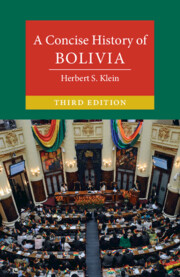Book contents
- A Concise History of Bolivia, Third Edition
- Cambridge Concise Histories
- A Concise History of Bolivia Third Edition
- Copyright page
- Contents
- Preface to the Third Edition
- Preface to the Second Edition
- Preface to the First Edition
- Chapter 1 Geography and Pre-Columbian Civilization
- Chapter 2 The Creation of a Colonial Society
- Chapter 3 Late Colonial Society: Crisis and Growth
- Chapter 4 Revolution and the Creation of a Nation-State, 1809–1841
- Chapter 5 The Crisis of the State, 1841–1880
- Chapter 6 The Ages of Silver and Tin, 1880–1932
- Chapter 7 Disintegration of the Established Order, 1932–1952
- Chapter 8 From the National Revolution to the Cold War, 1952–1982
- Chapter 9 Creating a Multiethnic Democracy, 1982–2002
- Chapter 10 The Emergence of a Mestizo and Indigenous Elite
- Political Chronology
- Tables
- Bibliography
- Index
Chapter 6 - The Ages of Silver and Tin, 1880–1932
Published online by Cambridge University Press: 02 December 2021
- A Concise History of Bolivia, Third Edition
- Cambridge Concise Histories
- A Concise History of Bolivia Third Edition
- Copyright page
- Contents
- Preface to the Third Edition
- Preface to the Second Edition
- Preface to the First Edition
- Chapter 1 Geography and Pre-Columbian Civilization
- Chapter 2 The Creation of a Colonial Society
- Chapter 3 Late Colonial Society: Crisis and Growth
- Chapter 4 Revolution and the Creation of a Nation-State, 1809–1841
- Chapter 5 The Crisis of the State, 1841–1880
- Chapter 6 The Ages of Silver and Tin, 1880–1932
- Chapter 7 Disintegration of the Established Order, 1932–1952
- Chapter 8 From the National Revolution to the Cold War, 1952–1982
- Chapter 9 Creating a Multiethnic Democracy, 1982–2002
- Chapter 10 The Emergence of a Mestizo and Indigenous Elite
- Political Chronology
- Tables
- Bibliography
- Index
Summary
The year 1880 marked a major turning point in Bolivian history. To contemporaries, the most dramatic event of this year was the utter defeat of Bolivian arms at the hands of the Chilean invaders and the loss of its entire coastal territory in the War of the Pacific. Less dramatic but equally important was the establishment of a new government to replace the previous caudillo regime. Although the replacement of governments by military coups was a common feature of political life in the republic since its creation fifty-five years previously, the new regime did in fact mark a fundamental change in national political development. It represented the first viable republican government of a civilian oligarchic nature, which would become the norm of political life until 1934. Although the loss of its direct access to the sea would remain the most intransigent of Bolivia’s international problems from 1880 to the present day, the establishment of a modern political party system and a civilian-dominated government would cause long-term political, economic, and eventually even social and cultural changes within Bolivian society, changes that were profoundly to shape its historical evolution.
- Type
- Chapter
- Information
- A Concise History of Bolivia , pp. 144 - 177Publisher: Cambridge University PressPrint publication year: 2021

